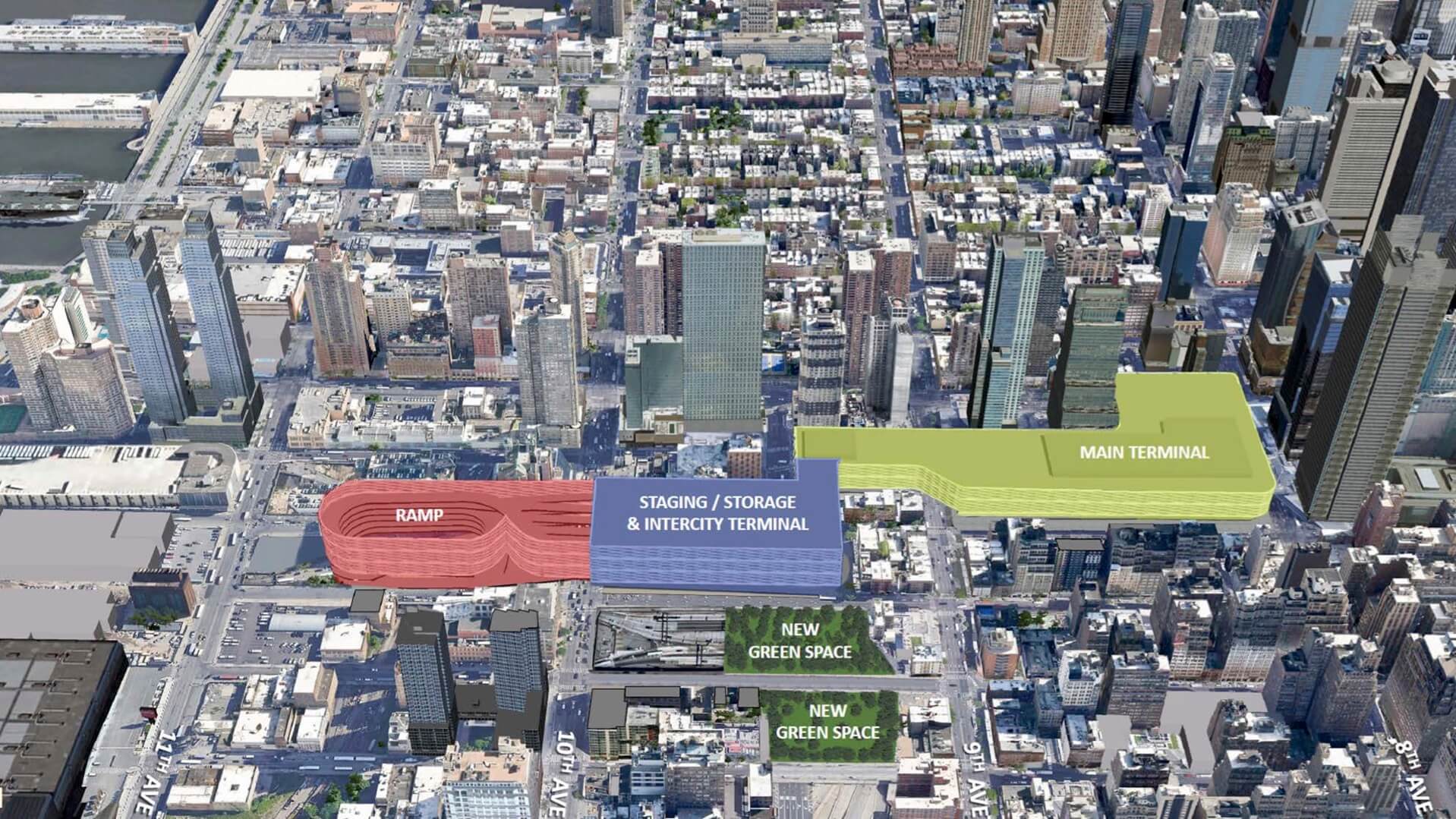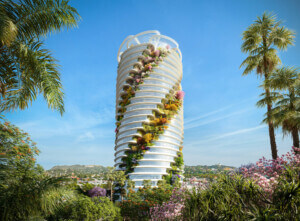In a major step forward in a years-long scheme to retire the grime-encrusted snarl of ramps and corridors known as the Port Authority Bus Terminal, the Port Authority of New York and New Jersey has revealed the two-firm team that will lead the design of a sparkly new Midtown Manhattan bus hub: Foster + Partners and the Chicago-headquartered design and engineering firm Epstein. The latter firm has helmed numerous large-scale infrastructure and civic projects and, notably, partnered with FXCollaborative to develop an expansion plan for the nearby Jacob K. Javits Center. As for Foster + Partners, the London-based global firm has numerous high-profile transport projects under its belt.
In a statement, Port Authority executive director Rick Cotton referred to the architectural team as “exceptional” and noted that their selection demonstrates that the bi-state agency is “laser-focused on building a truly visionary world-class facility worthy of the region, prioritizing both bus riders and the community surrounding the bus terminal.”
The two firms will “provide architectural design services for the replacement project beginning immediately and throughout the design phase and the environmental review of the proposed project,”a news release detailed.

The bus terminal replacement project was first announced early last year by the bi-state agency after previous plans and proposals, some of which envisioned burying the terminal underground or relocating it altogether, fizzled. Informed by extensive public feedback, the highly complex current plan, as proposed, involves razing the current bus terminal, an International Style behemoth straddling Eighth and Ninth avenues between 41st and 42nd streets, and constructing a state-of-the-art transit hub within the same footprint.
The LEED-targeting new facility would be equipped with a bevy of bells and whistles—electric bus charging stations, sensor-based monitoring systems, heat recovery reuse, on-site renewable energy generation, AI, technology and more—and designed to accommodate larger vehicles, which the outdated existing terminal cannot. In its new home, the (currently) bottleneck-plagued transit hub’s commuter and intercity bus capacity is poised to jump 40 percent. Also envisioned is a separate storage and staging facility accommodating intercity buses, which currently pick up and drop off passengers on nearby local streets, as well as a decked ramp structure linking the terminal with the Lincoln Tunnel that would be topped with a 3.5-acre swath of public green space. On the street-level, the new terminal will be ringed with “community-friendly” retail space.
“We are delighted to be appointed to the project, continuing to develop and maintain a unified vision for the Midtown Bus Terminal in Manhattan,” said Juan Vieira-Pardo, partner at Foster + Partners, in a statement. “Already the world’s busiest bus terminal, the project also has the potential to become the most desirable destination in Midtown.”

The likelihood that a bus terminal will become the “most desirable destination in Midtown” is, well, a stretch. But there’s no arguing that the new facility will be an improvement over the current situation: a key Northeast transit hub trapped in a state of obsolescence and anticipated to experience a 30 percent increase in demand through 2040 demand based on pre-pandemic ridership trends. The complex—dark, dank, disorienting—is (almost) universally loathed.
Port Authority Bus Terminal is, as mentioned by Vieira-Pardo, the world’s busiest and the largest in the Western Hemisphere. The original terminal, now known as the South Wing, first debuted in 1950 to acclaim; it gained a three-level vertical parking deck supported by a now-deteriorating concrete truss structure in the early 1960s, followed by the North Wing annex in 1979. Things have changed vastly since the rough-and-tumble New York City of the 1970s and 80s when the Times Square–adjacent terminal and the area around it had what can only be described as a reputation.
The construction of the new terminal will be a carefully phased process as it directly replaces the current one. “Tentative plans call for a phased construction approach with the staging and bus storage facility to occur first, so that it can serve as a temporary terminal while the existing terminal is being demolished and rebuilt,” the Port Authority explained. “The decking over of sections of Dyer Avenue would occur early in the phased construction also providing temporary bus staging locations while the main bus terminal is completely rebuilt. Once completed, the decked over areas of Dyer Avenue would become important public green space that reknits the local community.”
While the new Midtown Bus Terminal would rise on the same site as the existing terminal, the larger redevelopment proposal calls for the construction of a quartet of high-rise towers in the immediate vicinity: One on Eighth Avenue between 41st and 42nd streets; one on Ninth Avenue between 40th and 41st streets; one on 11th Avenue between 39th and 40th streets; and one on 10th Avenue between 39th and 40th streets. The development of these towers on Port Authority–owned property would help to finance the ambitious $10 billion project via the sale of air rights. An estimated $3 billion will come from the Port Authority’s capital budget; the agency is also seeking federal funding.
As for the project’s current status, it is now entering the federal National Environmental Policy Act (NEPA) review stage. As this process moves along, “ongoing planning conversations and public outreach will increase stakeholder engagement,” explained the Port Authority. “The process entails the issuance of a draft environment impact statement (EIS), a public hearing and comment period on that document, and an expected release of a final EIS in summer 2023.”
In other words, there’s still a long way to go before the much-reviled current bus terminal comes down and the new one rises. The Port Authority has said it hopes to open the new facility by 2032. AN will share new developments as they emerge.











